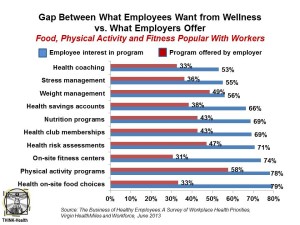 Health, happiness and engagement among employees are closely-linked and drive productivity in the workplace. But there’s a gap between the kind of wellness services employers offer workers to bolster health, and the programs that people actually want.
Health, happiness and engagement among employees are closely-linked and drive productivity in the workplace. But there’s a gap between the kind of wellness services employers offer workers to bolster health, and the programs that people actually want.
The current state of employer wellness programs is described in a survey conducted by Virgin HealthMiles and Workforce, The Business of Healthy Employees: A Survey of Workplace Health Priorities, published in June 2013.
There’s a gap between what workers want for wellness and what employers are offering. Most-demanded by workers are health on-site food choices desired by 79% of employees; but, only 33% of companies offer that healthy food that workers say they want. On the other hand, one-half of workplaces offer smoking-cessation programs, but only 13% of workers are interested in those. Fitness centers – desired by 3 in 4 employees – are offered to less than 1 in 3 employees.
The key findings from the survey are that:
- 87% of employees consider health and wellness offerings when picking a job
- 7 in 10 employees say wellness programs positively influence work culture, and 58% of workers believe their participation in wellness programs have a positive influence on colleagues, friends and family
- Incentives are important: while for 78% the #1 reason for participating in a wellness program is to improve health, 61% of employees also say incentives earned through wellness programs are a key reason they participate
- Most communication about wellness programs is via email, but employees don’t feel too clued into the program offerings
- Measuring ROI on wellness continues to challenge companies offering the programs. Only 31% of organizations deploying wellness programs are satisfied with the metrics they use to measure success of the benefits.
Two-thirds of the incentives used in wellness programs are “carrots,” and 29% offer both carrots and sticks to induce involvement in the programs. Only 3.5% of employers use only “sticks” as incentives to motivate.
The top 10 benefits employee perceive from participating in wellness programs are,
- Feeling healthier and happier, among 55%
- Improving overall well-being, 54%
- Losing weight and/or lowering BMI, 49%
- Having more energy, 48%
- Receiving financial rewards, 29%
- Improving control of chronic conditions, 27%
- Fewer sick days, 22%
- Lowering health care premiums, 21%
- Improving morale, 21%
- Supportive social connections, 17%
- Reducing dependence on meds, 9%.
The biggest obstacles to deploying successful wellness programs include the lack of ability to measure their impact, budget, concerns about changing employee behavior, and access to data needed to make decisions.
Health Populi’s Hot Points: Here’s a case where if you build it, only some employees will come — not because they’re alienated or turned off by wellness programs, but because a plurality of workers are simply not aware of the services available that can help them improve their health, and ultimately the health of the workplace. Health is social, the data from this survey show: workers like not only feeling energetic and positive about health, but the impact the programs have on co-workers and workplace morale. That’s faulty communication between employer and employee.
There’s a second aspect of communication that might also prevent the full realization of benefits and outcomes from wellness programs: this is communication about the Affordable Care Act between the Federal Government (White House and Department of Health and Human Services) and employers. That’s because most employers do not plan to take advantage of the wellness incentives that the ACA affords them. That incentive is that in 2014, companies offering health insurance with wellness programs can earmark financial incentives from 20% to 30% of the company’s total health plan costs. That percentage will be 50% for smoking cessation programs.
And, employees who smoke, we recently learned, cost an employer $6,000 more a year than workers who never smoked.
So there’s a simple-to-calculate hard ROI that’s calculable on targeting smoking through a wellness program, taking advantage of a very generous financial incentive.




 Interviewed live on BNN Bloomberg (Canada) on the market for GLP-1 drugs for weight loss and their impact on both the health care system and consumer goods and services -- notably, food, nutrition, retail health, gyms, and other sectors.
Interviewed live on BNN Bloomberg (Canada) on the market for GLP-1 drugs for weight loss and their impact on both the health care system and consumer goods and services -- notably, food, nutrition, retail health, gyms, and other sectors. Thank you, Feedspot, for
Thank you, Feedspot, for  As you may know, I have been splitting work- and living-time between the U.S. and the E.U., most recently living in and working from Brussels. In the month of September 2024, I'll be splitting time between London and other parts of the U.K., and Italy where I'll be working with clients on consumer health, self-care and home care focused on food-as-medicine, digital health, business and scenario planning for the future...
As you may know, I have been splitting work- and living-time between the U.S. and the E.U., most recently living in and working from Brussels. In the month of September 2024, I'll be splitting time between London and other parts of the U.K., and Italy where I'll be working with clients on consumer health, self-care and home care focused on food-as-medicine, digital health, business and scenario planning for the future...